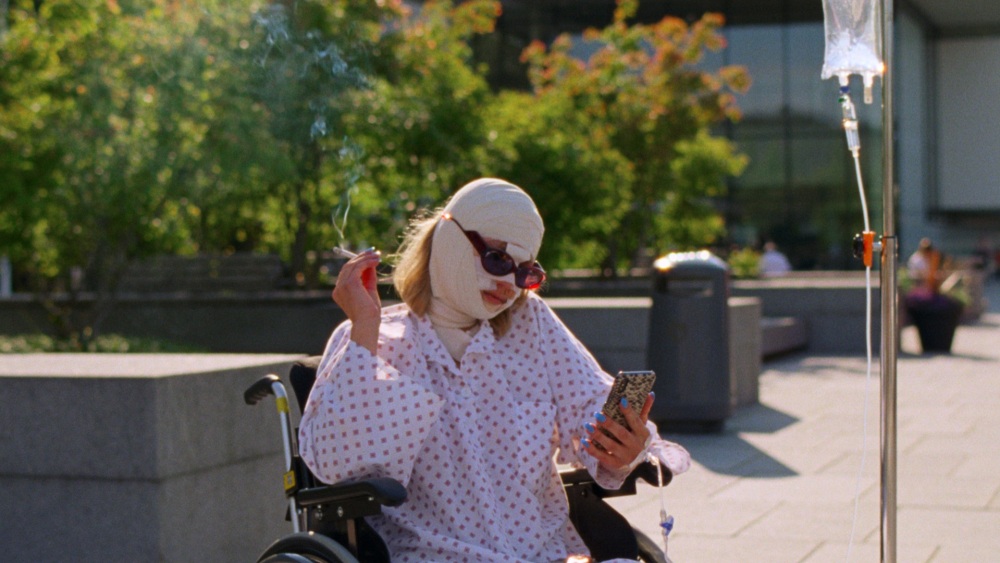
If Lars von Trier hadn’t grown top-heavy with the mythology of his self-importance (I’d say that happened around the time of “Antichrist,” in 2009), he might have tossed off a movie like “Sick of Myself” — a social satire in the form of a queasy drama of body horror, and a movie whose disturbing bad-boy tastelessness recalls Von Trier’s “The Idiots,” with a touch of David Cronenberg. This is the second feature by Kristoffer Borgli, the Norwegian writer-director whose first film, “Drib” (2017), was a send-up of the marketing industry, and in a way the new movie is about marketing too. This one, though, takes a viscerally upsetting look at just how far an individual will go to gain attention in the new era of social-media addiction.
The movie, which premiered at Cannes last year, arrives from the same production team that backed “The Worst Person in the World,” and part of the offbeat way the film gets its hooks in you is to exude a very similar sort of neutrally observed Scandinavian bourgeois vibe. This one, too, is set in Oslo, and it’s about a youngish couple who live together: Signe (Kristine Kujath Thorp), a barista with an anxious pensive aura, and her boyfriend, Thomas (Eirik Sæther), a handsome aspiring artist with an indulgent whim toward public infamy. Early on, the two are seated at a restaurant celebrating Signe’s birthday when Thomas uses the occasion to run off with a $2,300 bottle of wine, just because he can. His art draws on a similar impulse: He builds it out of stolen furniture, creating installations that are just hideous enough to result in his having a next-big-thing moment.
But “Sick of Myself,” for all of Thomas’s self-adoring showmanship, is Signe’s story, and she’s such a wallflower of the spirit that it takes a while for the audience to register just what’s up with her. When a pedestrian, bitten by a dog in the throat, stumbles into the coffee shop where Signe works, she nurses her and maybe saves her life — a Samaritan act, though Signe winds up feasting on the attention. She’s been bitten by the bug of notoriety. At a dinner party with Thomas, she improvises a way to extend the spotlight: She fakes having a nut-allergy attack, her closed-throat coughing fit soaking up all the energy in the room.
At this point, let me say upfront that I was close to writing off the movie. That fake allergy attack is something only a deeply unhinged narcissist would do, and Borgli, as a filmmaker, has failed to establish in any way that Signe is that sort of person. If “Sick of Myself” were a “psychological drama,” one might have to say that it lacks a crucial element of convincingness. But though the movie isn’t quite a fantasy, it is very much a horror film, one that operates according to a suck-in-your-breath logic of the grotesque that it’s hard to argue with because it hits you on such a gut level. It’s really a monster movie, with Signe as the monster who, like Dr. Jekyll or the Wolfman, undergoes her own staggering transformation.
Hooked on the new ethos of exhibitionism, which allows her to compete with the navel-gazing obnoxiousness of Thomas the Oslo art-world celebrity, Signe stumbles onto a news item about an anti-anxiety medication manufactured in Russia, called Lidexol, that had a catastrophic side effect, causing rashes that look like blotchy arteries to erupt right out of your skin. Signe knows a drug dealer, the jittery Stian (Steiner Klouman Hallert), who can get anything for you on the dark web. He orders her a shipment of Lidexol, and as soon as she gets hold of the large yellow pills, she starts to pop them. They have a sedative effect (her eyelids droop in the middle of the day), but then, right on cue, the rash arrives, like a reddish flower stem growing on her arm and face. At first it could almost be a tattoo. Then the ridges get deeper and uglier. Then she starts to look like an accident victim. It’s “Night of the Living Disfigurement.”
In the old transformational horror films (and most of the new ones), the hero is essentially a victim. He or she doesn’t choose to be a vampire, or a slasher demon, or whatever. Yet Signe chooses to become the bio-medical Elephant Woman of Oslo, and the horror of that choice — which is psychological — is the dramatic motor of “Sick of Myself.” As Signe, wrapped in bandages, becomes an object of there-but-for-the-grace-of-God sympathy within her circle, then a kind of public victim, then a news story, then an even bigger news story, what we know — and what no one else does — is that she has chosen to look this way. She embraces sickness over health. She chooses a kind of deformed martyrdom over the even more unendurable horror of anonymity. She’s a tabloid monster now. But she’s also a star!
Most horror movies have teams of visual-effects artists devising the latest digital insanity, but the visual-effects team of “Sick of Myself,” led by the makeup designer Dimitra Drakopoulou, bring off something low-key and artful. They make the slow corrosive degeneration of Signe’s face into something squeamish and real. Kristine Kujath Thorp, under that makeup, gives a haunted performance; she shows us how Signe is trapped in a misery that’s also feeding her. “Sick of Myself” pushes itself further and further into a kind of deadpan depravity. As Signe gets famous, her image becomes hip, embraced by the new inclusionary impulse in fashion. She’s made part of the marketing campaign for a new genderless clothing line (shooting a commercial backed by throbbing dance music, she stares into the camera and says the line, “Regardless means it fits me. Regardless”). The satire is a touch didactic, yet if “Sick of Myself” is threadbare around the edges, the film is onto something: how Signe uses the diseased image she’s created to replace herself. Because she thinks she doesn’t have a self.











